World War I and St Edmund Hall
To mark the centenary of the Armistice that signalled the end of World War I, the College held an exhibition of items from the library and archive relating to St Edmund Hall and the War, located in the Chapel, close to the war memorial panels. Below is a digital version of the display, which was organised by James Howarth (Librarian) and Rob Petre (Archivist).
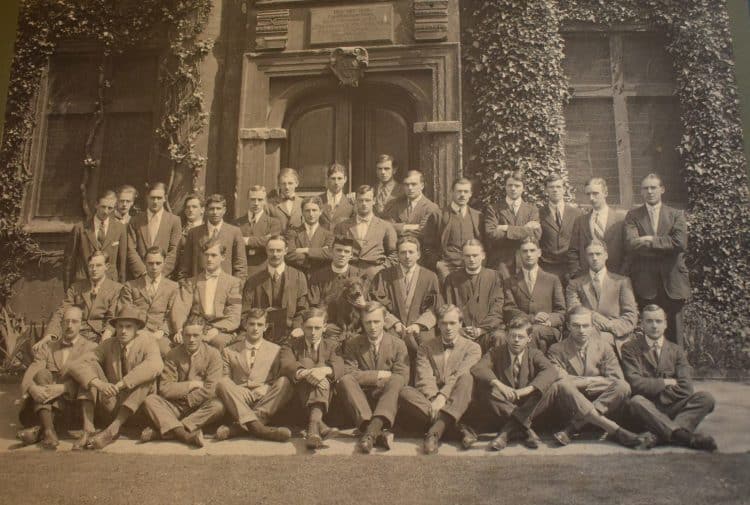
Letter from the Principal, including description of wartime Oxford, 16 October 1914
Ref: PRI 2/56/7
The Principal, Bishop Henry Williams, writes to a former student, Burrell, to thank him for a generous donation to the Hall. He explains that he has had to call off the fundraising appeal, due to the war, and then powerfully describes wartime Oxford. A photocopy of the letter can be viewed here, and the following is a short extract:
“The [Examination] Schools have been turned into a military hospital with over 500 beds filled at present largely with Belgian wounded. Christ Church, Keble, Exeter and New College are mostly military barracks. There are almost a third of the usual number of undergraduates in residence and most of them are training with the Officers’ Training Corps and will vanish at Christmas or Easter.”
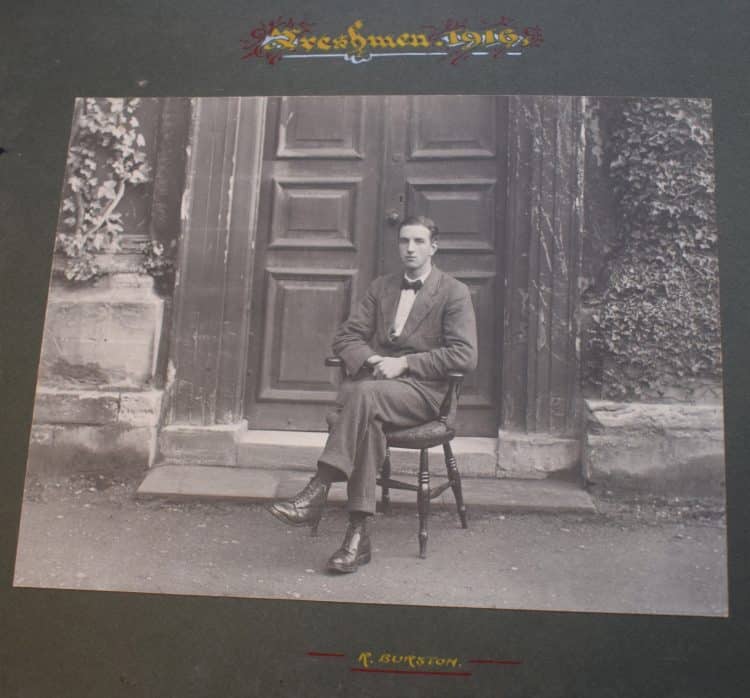
Junior Common Room photograph album
Ref: JCR 5 A/3
The album includes annual photographs of the Common Room and each year’s Freshmen, a tradition which continues to this day with our annual Freshers’ Matriculation photos. Poignantly, in 1916, there is just a single student in the Freshmen picture. In 1917, the photo of the whole Common Room features just 14 people, including 3 dons.
There are also photographs of the Officers’ Training Corps (OTC) for 1912, 1913 and 1914. The OTC was a response to the poor showing of the Army in the Boer War and the growing tension with Germany in the 1900s (see books like The Riddle of the Sands by Erskine Childers).
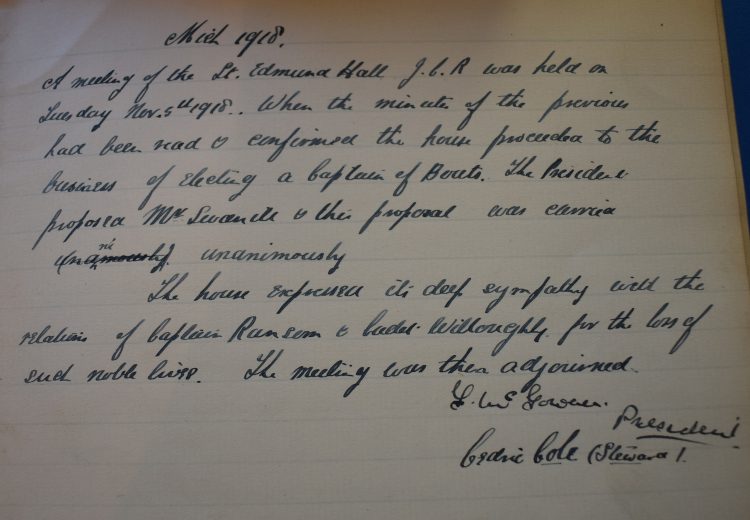
Junior Common Room minute book - 1910-1921
Ref: JCR 1/1
The minutes for 5 November 1918 record the loss of Captain Ransom and Cadet Willoughby, whilst also showing that life went on at the Hall despite the privations of war. Ransom and Willoughby were probably the last two Hall men to die before the Armistice. (Gilbert Henry Salmon is later on the memorial board, but he died in Mesopotamia in 1919 as a political officer in the British Protectorate.)
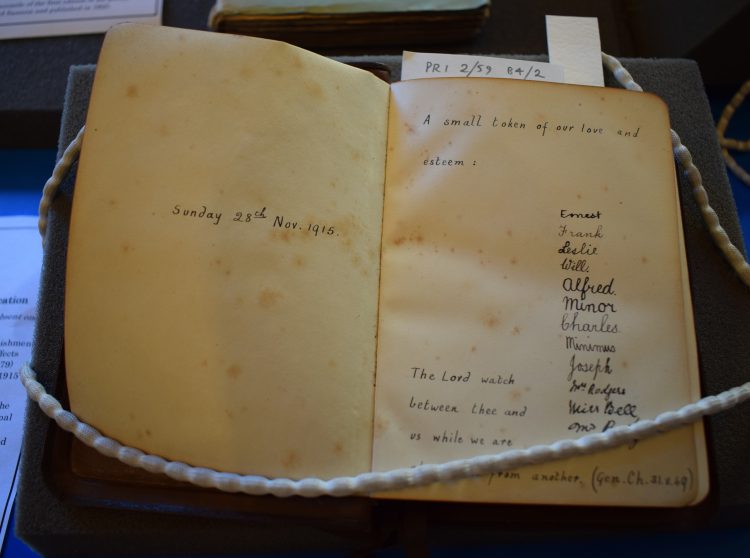
Bible belonging to A.B. Emden with dedication
“The Lord watch between thee and us, when we are absent one from another.”
When the Old Library was cleared for its refurbishment in 2018, we found a small chest of drawers filled with personal effects from across the life of Alfred Brotherston Emden (1888-1979) including this small Bible presented to him in November 1915 when he was called up to the Navy.
In 1915, Emden was yet to begin his long association with the Hall (Tutor and Bursar 1919, Vice-Principal 1920-29, Principal 1929-51) and was teaching at Edgill House, a school for disadvantaged children in Sydenham. The Bible was presented by pupils and staff. He joined St Edmund Hall as Tutor in History immediately on being demobbed in 1919. It was said he gave his first tutorials still wearing naval bell-bottomed trousers.
During World War II, Emden was instrumental in setting up naval reserve units in British universities and commanded the Oxford University Naval Division from 1942-4.
Postcards from the First World War, 1914-1918
Ref: X6
Most of these postcards seem to have been intended either to boost morale or to condemn the Germans. The collection was unlabelled when we found it, but we suspect that it belonged to Principal Emden. It includes a message home from a Prisoner of War in Germany to his wife back in Yorkshire.
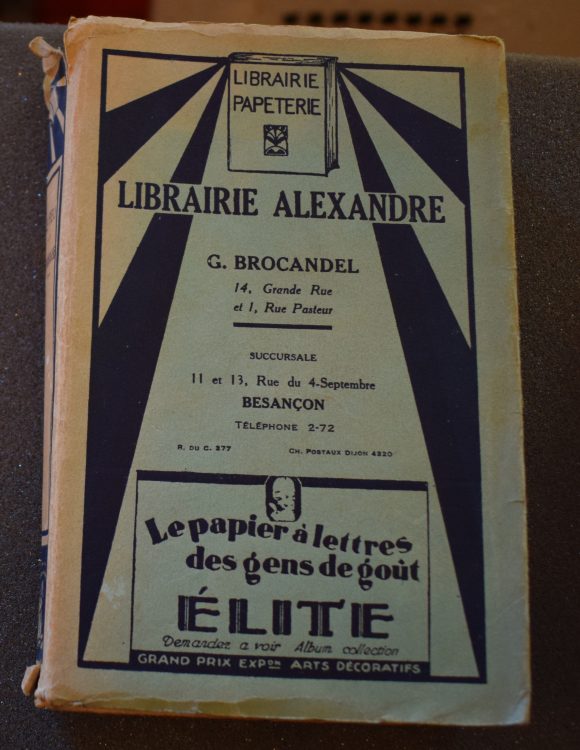
Henri Barbusse, Le Feu (Paris: Flammarion, c.1917) & Wilfred Owen, Poems (facsimile of first edition – London, Chatto & Windus, 1920)
Le Feu (published in English as Under Fire) was one of the first published books giving a realistic and graphic account of the fighting on the Western Front. It was based on the experience of its author, Henri Barbusse, in the French army in 1914-15 and won the Prix Goncourt in 1916. The Hall’s copy is part of a large recent donation of French books given to the Library by J.M. Dening (1958, Modern Languages). The book still has the custom dust jacket of the book shop in Besançon where his father purchased it in 1929.
Barbusse’s work was very influential on the war poetry of Wilfred Owen, who read the book in December 1917 after he had been discharged from hospital for shell shock. Owen returned to France in July 1918 and was killed on 4 November 1918. The telegram informing his Mother arrived on Armistice Day.
Our display included a facsimile of the first edition of his poems edited by Siegfried Sassoon and published in 1920.
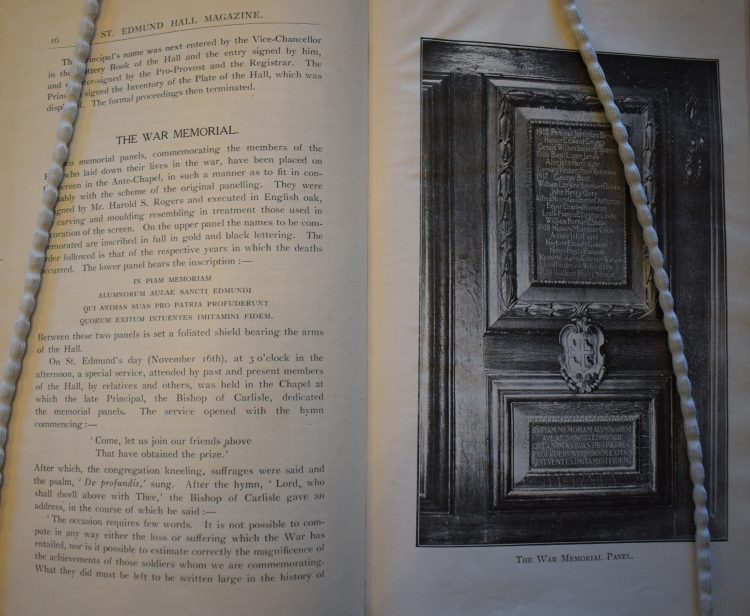
‘The War Memorial’ St Edmund Hall Magazine 1920-21, pp.16-18
The second ever issue of the Hall’s Magazine carried an account of the dedication of the War Memorial on St Edmund’s Day (16 November) 1920 by Henry Herbert Williams, the Bishop of Carlisle, who had been Principal during the War.
He gave an address including his own recollections of those who had died and said “it is not possible to compute either the loss or the suffering which the war has entailed, nor is it possible to estimate correctly… the achievements of those we are commemorating.”
Throughout the 1920s, subsequent issues of the Magazine record the presentation of a wreath of rosemary (for remembrance) for the memorial every St Edmund’s Day by the Bishop and his wife.
In the 2014 edition of the Magazine, Principal Keith Gull wrote about the memorial panel, and listed the names of all the members of St Edmund Hall who are included on the Roll of Service. That article can be found here.
Order of Service for dedication of St Edmund Hall War Memorials, 1921
Ref: FB 2 D2
The order of service includes an honour roll on paper, which was pinned in the Chapel prior to the dedication of the wooden memorial board. The honour roll includes M. C. Akabandhu, a Siamese prince from Bangkok, who was killed by enemy action but not as a serviceman, and was therefore not listed on the wooden memorial.
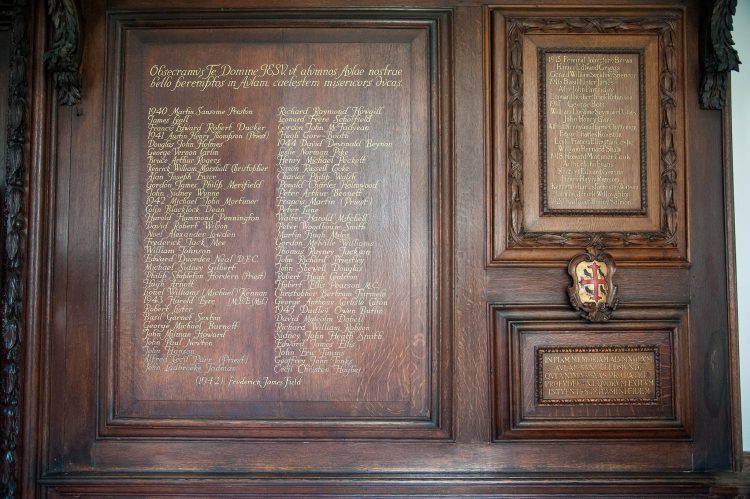
Remembrance Sunday 2018
As a mark of remembrance and respect, the JCR invited all members of the College community to form the shape of a poppy in the Front Quad on 11 November 2018. Students, Fellows and staff came together to mark the centenary of the Armistice – and a short video of the ‘human poppy’ can be viewed here.